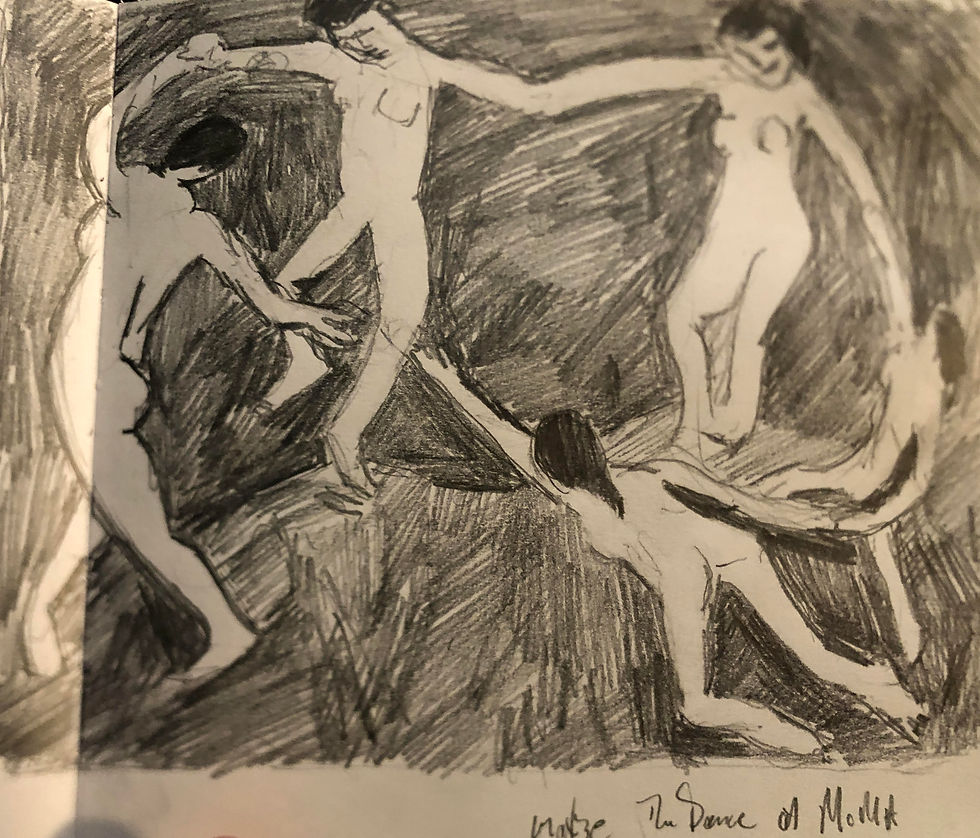MoMA and Hadestown: Rothko, Matisse and Anais Mitchell
- Joel Klepac

- Nov 22, 2022
- 3 min read

Arrested by the Dance (1909) by Henri Matisse, I sat and drew it in my 6x6 inch sketchbook. The figures form a wild chain in a distorted oval shape, arm melding into arm, bodies flying, feet following the flow around the wild chain. Faces are obscured and dark masses of hair create a visual rhythm. One figure is so distorted it would be hardly recognizable as a figure alone, but in the flow of bodies is simply another piece of the chain. The minimalist palette of green hill under the blue sky gently lift the fleshy bodies and hold them in mid air.
A transcendent dance clear of all earthly care beckons the viewer to step through, step up, into the sublime dance, a oneness with other creatures, the oneness of purpose, of direction, of joy, of overflow. Some have wondered, is the naivete of Matisse possible after the great wars? Is it even possible now? Is it worth dreaming of a future of concelebration, a dance of humanity rather than war and mutual annihilation?

(The Dance sketch by Joel Klepac)
My second arrest of the day came with the Rothko, “No. 5/No. 22”, a nice ambiguous name for fear of giving the viewer something to hang their hat on and think they got it. We can’t even settle on one number for the title. To enter the color fields is to enter the Rumi fields beyond wrongdoing and rightdoing. It is the land of non-dualism immanent and transcendent at once. This is the same field of Matisse's dance. Rumi may have seen the same dancers there. Rothko may have sought a purely emotional experience in the flood of color vibration, but what he got was a transcendent plane where we all share 7 basic emotions, we all long for those fields of belonging, curiosity, and sublime peace.
A few blocks down I descended into Hades Town for a few hours. The musical is based on the tragedy of Orpheus, Eurydice, Hades, Persephone, and Hermes played this afternoon by Sayo Oni, Grace Yoo, Patrick Page, and Eva Noblezada. You are warned from the beginning it is a tragedy, and yet you go into the underworld still wishing that somehow it will work out, that Orpheus’ song will lead to the freedom of Eurydice and anyone else who would follow his song of hope. The beauty of his melody even assuages the power-hungry tyrant Hades. As an artist, I love that it is the lone person with a guitar trying to save the world, and find the melody that sets us all free.
Of course, Anais Mitchell is the songster genius with her guitar humming out the melodies that would take an audience out of their comfortable 100$ seats into the underworld of poverty and oppression with the idealism that this musical could instill even the slightest vision of a new world where we can really see one another. “If we're free/ tell me when/ we can stand with our fellow man” Even though the tragedy repeats itself the truth remains, that sublime beauty humanizes even Hades, and softens him by the reminder of his love of Persephone. The songbird is more powerful than the almighty lord of the underworld. And so the audience is carried upon the sizzling brass, haunting strings, and oh-so-earthy magic of the acoustic guitar in and back out of the underworld of our human experience.
In the end, it comes down to the inner battle of doubt, Orpheus’ faith that his love is there with him. If only he could hold onto the belief through the dreary passages and believe that he was not alone he could lead us all out. If only we could believe in the sublime beauty, a transcendent non-dualistic reality where we dwell in Rumi’s field, Matises Dance and Orpheus’ melody the world would be saved from the reign of Hades. The greatest impediment is in our heads. The forgetting of the holy place deeper than our categories.
Beauty takes us there. A sense of the sacred nature of all things, of all people everywhere, takes us there. In the end, Orpheus sings, “Doubt comes in and my heart falters/ and forgets the songs it sung/ where are you? where are you now?”
Joel Klepac finds joy and wonder exploring the world through the practices of hiking, providing therapy, drawing, fiddling, encaustic painting, writing, and spirituality. You can find his art and musings at joelklepac.com and https://joelklepac.medium.com.


Comments